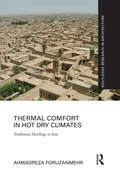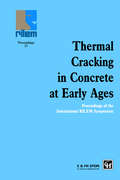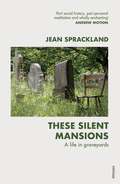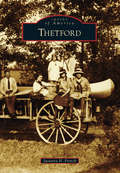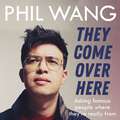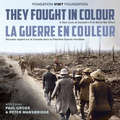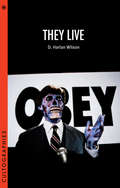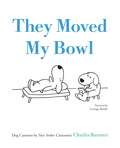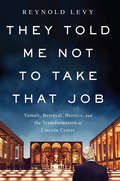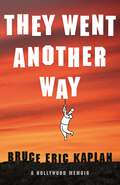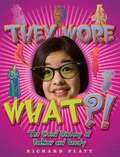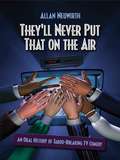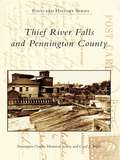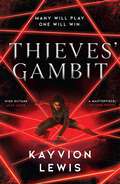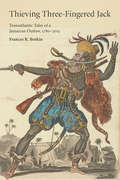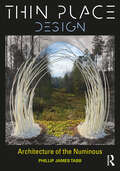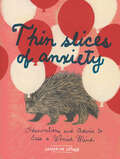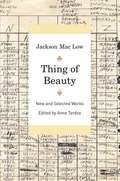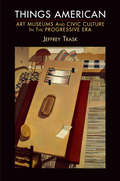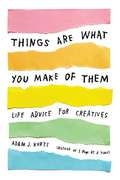- Table View
- List View
Thermal Comfort in Hot Dry Climates: Traditional Dwellings in Iran (Routledge Research in Architecture)
by Ahmadreza ForuzanmehrWith increases in global temperatures, the risk of overheating is expected to rise around the world. This results in a much higher dependency upon energy-intensive cooling systems and air-conditioners to provide thermal comfort, but how sustainable is this in a world where problems with the production of electricity are predicted? Vernacular houses in hot and dry central Iran have been adapted to the climate through passive cooling techniques, and this book provides a valuable assessment of the thermal performance of such housing. Shedding new light on the ability of traditional housing forms to provide thermal comfort, Thermal Comfort in Hot Dry Climates identifies the main cooling systems and methods in traditional houses in central Iran, and examines how architectural elements such as central courtyards, distinct seasonal rooms, loggias, basements and wind-catchers can contribute to the provision of thermal comfort in vernacular houses.
Thermal Cracking in Concrete at Early Ages: Proceedings of the International RILEM Symposium
by R. SpringenschmidRestraint and intrinsic stresses in concrete at early ages are vitally important for concrete structures which must remain free of water-permeable cracks, such as water-retaining structures, tunnel linings, locks and dams. The development of hydration heat, stiffness and strength, also the degree of restraint and, especially for high-strength concr
Thermal Energy Storage with Phase Change Materials: A Literature Review of Applications for Buildings Materials (SpringerBriefs in Applied Sciences and Technology)
by João M.P.Q. Delgado Joana C. Martinho Ana Vaz Sá Ana S. Guimarães Vitor AbrantesThis short book provides an update on various methods for incorporating phase changing materials (PCMs) into building structures. It discusses previous research into optimizing the integration of PCMs into surrounding walls (gypsum board and interior plaster products), trombe walls, ceramic floor tiles, concrete elements (walls and pavements), windows, concrete and brick masonry, underfloor heating, ceilings, thermal insulation and furniture an indoor appliances.Based on the phase change state, PCMs fall into three groups: solid–solid PCMs, solid–liquid PCMs and liquid–gas PCMs. Of these the solid–liquid PCMs, which include organic PCMs, inorganic PCMs and eutectics, are suitable for thermal energy storage. The process of selecting an appropriate PCM is extremely complex, but crucial for thermal energy storage. The potential PCM should have a suitable melting temperature, and the desirable heat of fusion and thermal conductivity specified by the practical application. Thus, the methods of measuring the thermal properties of PCMs are key.With suitable PCMs and the correct incorporation method, latent heat thermal energy storage (LHTES) can be economically efficient for heating and cooling buildings. However, several problems need to be tackled before LHTES can reliably and practically be applied.
Thermal Insulation and Radiation Control Technologies for Buildings (Green Energy and Technology)
by Jan Kośny David W. YarbroughThis book offers a unique treatment of building insulating products and the integration of these products with building components. This book was written for all those involved in building design, specification, construction, and commissioning, providing them with an understanding of and appreciation for the wide variety of thermal insulation products and technologies available for use in all types of buildings. The book proceeds from basic definitions and discussion of heat-transfer topics and thermal insulation concepts, to the design and use of these products. The impact of thermal insulation on dynamic building performance, including factors other than heating and cooling, is also discussed.The book does not require an advanced mathematical background. The authors provide sufficient information to provide a qualitative understanding, with more mathematical sections included for those interested in modeling and analysis. The basic physics associated with heat transfer in buildings are presented, along with the steady-state and transient analysis techniques needed for the effective implementation of thermal insulation and assemblies.Modern building design involves the integration of comfort, safety, economics, durability and cost considerations, all of which impact the selection and use of thermal insulation materials in buildings. In addition to theoretical explanations of the underlying science, the book details the properties and application of new thermal insulation materials, including vacuum panels, gas-filled panels, aerogels, phase-change materials, and radiation control technologies.Given its scope, the book will be of interest to researchers and building engineers wishing to understand the latest technologies and materials available, so as to achieve reduced energy consumption in commercial and residential buildings.
These Silent Mansions: A life in graveyards
by Jean Sprackland'A refreshingly original meditation... I wish I had written it myself' Literary ReviewGraveyards are oases: places of escape, peace and reflection. Liminal sites of commemoration, where the past is close enough to touch. Yet they also reflect their living community - how in our restless, accelerated modern world, we are losing our sense of connection to the dead.Jean Sprackland - the prize-winning poet and author of Strands - travels back through her life, revisiting her once local graveyards. In seeking out the stories of those who lived and died there, remembered and forgotten, she unearths what has been lost.
Thetford
by Susanna H. FrenchSoon after Thetford was chartered in 1761, settlers from southern New England arrived and began transforming the forestland into a community. They took advantage of both the Connecticut River and the Ompompanoosuc River to forge a lively and self-sustaining collection of mill villages within the town. The railroad arrived in 1848, enabling three depot villages to blossom. Thetford Hill, with neither mills nor transportation, became home to the renowned Thetford Academy, the first coeducational secondary school in Vermont. Thetford's mill-based commerce ebbed significantly by 1900, but tourism became a prevalent industry, with city dwellers flocking to summer retreats such as Camp Hanoum and the Lake Fairlee camps. Despite fires, floods, and hurricanes, as well as the construction of the Union Village Dam in 1950 and Interstate 91 in 1971, Thetford has retained its resilient spirit and looks much as it did a century ago.
They Come Over Here: Asking Famous People Where They're Really From
by Phil WangComedian Phil Wang takes us through a funny and incisive look at race and belonging. Inspired by his forthcoming book Sidesplitter, Phil and a panel of guests explore the subjects of food, music, politics, nature and empire, and what they mean in today's multicultural society.Guests include comedian and Budpod co-host Pierre Novellie, singer-songwriter Emmy the Great, bestselling author and journalist Sathnam Sanghera, celebrity pastry chef Cherish Finden and many more. (P)2021 Hodder & Stoughton Limited
They Fought in Colour / La Guerre en couleur: A New Look at Canada's First World War Effort / Nouveau regard sur le Canada dans la Première Guerre mondiale
by Peter Mansbridge Daniel Poliquin The Vimy Foundation Paul GrossIconic photos from the First World War, newly colourized. See seminal images of Canada’s First World War experience in a new light — offered in full colour for the first time — with contributions from Margaret Atwood, Tim, Cook, Charlotte Gray, Paul Gross, Peter Mansbridge, and many others. Canadians today see the First World War largely through black and white photography. Colourizing these images brings a new focus to our understanding and appreciation of the role Canada played during the First World War. It makes the soldier in the muddy trench, the nurse in the field hospital, and those who waited for them at home come to life. Immediately, their expressions, mannerisms, and feelings are familiar. They become real. They Fought in Colour is a new look at Canada’s experience during the Great War. A more accessible look. A more contemporary look.
They Live
by D WilsonTraces the development of They Live from its comic book roots to its legacy as a cult masterpiece while evaluating the film in light of paranoid/postmodern theory
They Live
by Wilson D. HarlanTraces the development of They Live from its comic book roots to its legacy as a cult masterpiece while evaluating the film in light of paranoid/postmodern theory
They Live (Cultographies)
by D. Harlan WilsonBorn out of the cultural flamboyance and anxiety of the 1980s, They Live (1988) is a hallmark of John Carpenter's singular canon, combining the aesthetics of multiple genres and leveling an attack against the politics of Reaganism and the Cold War. The decision to cast the professional wrestler "Rowdy" Roddy Piper as his protagonist gave Carpenter the additional means to comment on the hypermasculine attitudes and codes indicative of the era. This study traces the development of They Live from its comic book roots to its legacy as a cult masterpiece while evaluating the film in light of the paranoid/postmodern theory that matured in the decidedly "Big 80s." Directed by a reluctant auteur, the film is examined as a complex work of metafiction that calls attention to the nature of cinematic production and reception as well as the dynamics of the cult landscape.
They Moved My Bowl: Dog Cartoons by New Yorker Cartoonist Charles Barsotti
by Charles Barsotti George BoothThis is the first, and long-overdue, book of Charles Barsotti's dog cartoons. Barsotti's distinctive round pups, rendered in just a few simple lines, have been delighting The New Yorker readers for three decades and are instantly recognizable for their depiction of canines in human roles. The juxtaposition of their simple world, consisting only of food, play, and the goings-on of their owners, with the utterly human tasks of going to therapy, talking business, or seeing a lawyer, is both adorable and hilarious. A dog standing at a podium announces, "If elected, I promise to beg, fetch, and roll over." An older dog frowns down at a young pup and says, "Don't be smug, all puppies are cute." An angry dog with brush in hand paints a "BEWARE OF DOG" sign. With an irresistible blend of biting humor and affectionate observation, this is a perfect gift book for dog lovers everywhere.
They Shouldn't Have Killed His Dog: The Complete Uncensored Ass-Kicking Oral History of John Wick, Gun Fu, and the New Age of Action
by Edward Gross Mark A. AltmanThere have been iconic moments in the action movie genre over the years, but nothing has come close to matching the kinetic, balletic gun-fu of the John Wick films.In They Shouldn’t Have Killed His Dog: The Complete Uncensored Ass-Kicking Oral History of John Wick, Gun-Fu and The New Age of Action, bestselling authors Mark A. Altman and Edward Gross take you behind the scenes of a franchise that includes three films with more on the way, while exploring the action classics that led to John Wick as well as the films it inspired, like Atomic Blonde. They bring you right into the middle of the action of the John Wick films, detailing how the seemingly impossible was achieved through exclusive interviews with the cast, writers, directors, producers, stuntmen, fight choreographers, cinematographers, studio executives, editors, critics, and more. Together, they break down key action sequences while also providing a look back at the road the action genre has taken that led to John Wick, and a look at the character itself, an anti-hero who carries on the grand tradition of Clint Eastwood’s Man with No Name, but with a twist — and a never-ending supply of ammo — while showcasing the enduring appeal of the action movie as well as John Wick’s unique reinvention of the genre.
They Told Me Not to Take that Job: Tumult, Betrayal, Heroics, and the Transformation of Lincoln Center
by Reynold LevyReynold Levy joined Lincoln Center in 2002. When he did so America’s leading arts venue was routinely described in terms like this: "Behind the scenes, however, Lincoln Center is a community in deep distress, riven by conflict over a grandiose $1 billion redevelopment plan... instead of uniting the Center’s constituent arts organizations behind a common goal, the project has pitted them against one another in open warfare more reminiscent of the shoot-out at the OK Corral than of a night at the opera. 'To say that it is a mess is putting it mildly,’ says Johanna Fiedler, the author and a former staff member at the Metropolitan Opera. 'There is nobody running the show right now. ’” (Leslie Bennetts, New York Magazine¸ February 4, 2002) To choose to be President of Lincoln Center of one’s own free will was regarded by Reynold Levy’s friends and mentors as bordering on a self-destructive act. Rivalries abounded. Personalities clashed. Egos reigned. Reputations were badly damaged. And many of the tensions were dramatically played out in public and assiduously reported by a delighted press. Levy had just spent six years traipsing through much of the Third World and many failed states as the President of the International Rescue Committee (IRC), one of the world’s leading refugee assistance organizations. Having dealt with the Democratic Republic of Congo, Rwanda, and Serbia, even Joe Volpe, the volcanic manager of the Metropolitan Opera seemed hardly daunting. Lincoln Center, its key figures with their bombast and betrayals was not South Sudan. So he set to, and during his presidency transformed Lincoln Center’s entire 16-acre campus including the city block from Broadway to Amsterdam Avenue. With the new Alice Tully Hall, the expansion of The Juilliard School, two new screening rooms and an education center for the Film Society, new dance studios for the School of American Ballet, came a beautifully designed, graceful welcome to Lincoln Center’s main campus, one filled with light and life. There were new green spaces, new restaurants, a totally wifi’d campus that displayed 21st Century technology indoors and out. And a remodeled, utterly transformed, privately owned public space called the David Rubenstein Atrium, named after its principal donor, a new Lincoln Center Commons, opened free of charge to the public 365 days a year. This book reveals the real story behind the 1. 2 billion dollar reinvention of Lincoln Center, and all the trials and triumphs along the way. It contains unique lessons for leaders in all kinds of organizations, cautionary tales for employees, volunteers and donors, and inspiring clarity for anyone who wants to lead an institution they believe in so that it can become the best version of itself.
They Went Another Way: A Hollywood Memoir
by Bruce Eric KaplanA darkly comic memoir about being a working creative person in a world that is growing ever more dysfunctional, by acclaimed New Yorker cartoonist and television writer Bruce Eric Kaplan.In January 2022, Bruce Eric Kaplan found himself confused and upset by the state of the world and the state of his life as a television writer in Los Angeles. He started a journal to keep from going mad, which eventually became They Went Another Way.The book’s through line traces his attempt to get a television project set up in the increasingly Byzantine world of Hollywood. But as he details the project’s ups and downs, Kaplan finds himself ruminating not only on show business but also on today’s political and social issues, on old movies and TV shows and music, on his family, on his friends, on his past, on his failing heating system, and on all the dead birds that keep showing up in his backyard.This hilarious and surprisingly moving book is about life—about art, about love, about alienation, about connection, about ugliness and beauty, about disappointment, wonder, and hope. In short, it is about everything.
They Wore What?!: The Weird History of Fashion and Beauty
by Richard PlattDescribes changing ideas of fashion and beauty through history and around the world.
They'll Never Put That on the Air: The New Age of TV Comedy
by Allan NeuwirthIn the 1950s, Lucille Ball couldn't even say the word "pregnant" on TV. But by the 1990s, Carrie Bradshaw and her posse could say everything there is to say about sex-and demonstrate most of it. How have broadcast standards changed from the dawn of television till today? Through interviews with the creators of landmark shows, author Allan Neuwirth traces that history, revealing how the upheaval of the 1960s led to edgier fare such as The Smothers Brothers Comedy Hour; how counterculture baby boomers made Saturday Night Live-style satire possible; how stand-up comedians changed the sitcom landscape; how UPN and the WB raised eyebrows with comedies aimed at minorities; and much more. In this age of FCC crackdowns, They'll Never Put That on the Air is as timely as it is entertaining and informative. Firsthand accounts of life in the TV trenches from producers and writers Handy "genealogy chart" traces TV comedy from the 1950s to today Insider author is an award-winning producer, director, and writer of TV comedy
Thief River Falls and Pennington County
by Pennington County Historical Society Caryl J. BuggePositioned on the east edges of the Red River Valley and the northern Minnesota Woodlands, Pennington County was settled by farmers of predominantly Scandinavian stock, and census surveys indicate that Thief River Falls was the "most Norwegian" city in the United States. These settlers broke the soil, planted grain, and traveled to the woodlands for logs with which to build their homes. They floated the trees they cut down the rivers to the mills in Thief River Falls, St. Hilaire, and Crookston. Grain elevators and flour mills stood out against the prairie skyline, and milled logs became ties for the railroads that would transport the lumber and grain to distant cities and ports. The postcards in this book depict the industries, buildings, and people of Pennington County.
Thieves' Gambit: The Waterstones prize-winning enemies to lovers heist (Thieves' Gambit (trade) Ser.)
by Kayvion LewisThe enemies-to-lovers heist with an ending everyone's talking about, winner of the Waterstones Children's Book Prize for Older Readers, 2024. Soon to be a major movie and picked for Zoe Ball's Radio 2 Book Club, for fans of Jennifer Lynn Barnes and Suzanne Collins. 'Strap in for the ride with this twisty, fast-paced heist' Daily MailChallenge: Join the Thieves&’ Gambit, a cut-throat competition to crown the world&’s greatest thiefRule 1: Never fall in love with your opponentRule 2: The only thief you can trust is yourselfEndgame: Win the heist to save your family - and yourself . . . Seventeen-year-old Rosalyn Quest was raised by a legendary family of thieves with one rule: trust no one. When her mother is kidnapped, her only chance to save her is to win the Thieves&’ Gambit – a deadly competition for the world&’s best thieves, where the victor is granted one wish. To win, she must outwit all of her backstabbing competitors, including her childhood archnemesis. But can she take victory from the handsome, charming boy who makes a play for her heart and might be hiding the most dangerous secret of all?*Pre-order the pulse-pounding sequel, Heist Royale, where love is an impossible mission . . . out November.* Praise for Thieves' Gambit: 'A propulsive, high-octane thriller that kept me guessing until the very end. Full of breathtaking heists, complex relationships, high-stakes tension, and characters I would follow anywhere, Thieves&’ Gambit gripped me from the first page, and never let go. You won&’t want to stop reading.'Alex Aster, #1 New York Times bestselling author of Lightlark 'Thieves' Gambit is a masterpiece! I love everything about this book from the twists and turns to the international settings and the characters. Kayvion Lewis has created a fast paced and dramatic story that had me addicted from beginning to end.'Natasha Bowen bestselling author of Skin of the Sea'This fast-paced heist thriller is incredibly assured with a blockbuster feel: highly cinematic'Observer 'A pulse-pounding thriller … addictive' B&N Reads 'Readers will experience the best kind of whiplash as the story moves from one heist to the next. A fast-paced roller coaster of a read' Kirkus Reviews 'Fresh descriptions of varied backdrops, including the Bahamas, Cairo, and France, elucidate wanderlust vibes in this edge-of-the-seat thriller' Publishers Weekly 'The high-octane stakes will appeal to fans of Jennifer Lynn Barnes and Ally Carter, and the twisty plotting is reminiscent of Ocean&’s 8. This new teen criminal will steal hearts' Booklist
Thieving Three-Fingered Jack: Transatlantic Tales of a Jamaican Outlaw, 1780-2015
by Frances R. BotkinThe fugitive slave known as “Three-Fingered Jack” terrorized colonial Jamaica from 1780 until vanquished by Maroons, self-emancipated Afro-Jamaicans bound by treaty to police the island for runaways and rebels. A thief and a killer, Jack was also a freedom fighter who sabotaged the colonial machine until his grisly death at its behest. Narratives about his exploits shed light on the problems of black rebellion and solutions administered by the colonial state, creating an occasion to consider counter-narratives about its methods of divide and conquer. For more than two centuries, writers, performers, and storytellers in England, Jamaica, and the United States have “thieved" Three Fingered Jack's riveting tale, defining black agency through and against representations of his resistance.Frances R. Botkin offers a literary and cultural history that explores the persistence of stories about this black rebel, his contributions to constructions of black masculinity in the Atlantic world, and his legacies in Jamaican and United States popular culture.
Thin Place Design: Architecture of the Numinous
by Phillip James TabbWhat makes the places we inhabit extraordinary? Why are some urban spaces more vital and restorative? Wonderful landscapes, inspiring works of architecture and urban design, and the numinous experiences that accompany them have been an integral dimension of our culture. Up-lifting spaces, dramatic use of natural light, harmonic proportional geometry, magical landscapes, historic sites and vital city centers create special, even sacred moments in architecture and planning. This quality of experience is often seen as an aesthetic purpose intended to inspire, ennoble, ensoul and spiritually renew. Architecture and urban spaces, functioning in this way, are considered to be thin places.
Thin Slices of Anxiety: Observations and Advice to Ease a Worried Mind
by Catherine LepageNot to worry, a book on anxiety is finally here! A clever antidote to everyday angst, this illustrated book captures universal truths and comforting revelations about being human. Artist Catherine Lepage uses her wry humor to help us see that "thinly sliced and illustrated, emotions are much easier to digest."
Thing of Beauty: New and Selected Works
by Jackson Mac Low Anne TardosThis landmark collection brings together poetry, performance pieces, "traditional" verse, prose poems, and other poetical texts from Jackson Mac Low's lifetime in art. The works span the years from 1937, beginning with "Thing of Beauty," his first poem, until his death in 2004 and demonstrate his extraordinary range as well as his unquenchable enthusiasm. Mac Low is widely acknowledged as one of the major figures in twentieth-century American poetry, with much of his work ranging into the spheres of music, dance, theater, performance, and the visual arts. Comparable in stature to such giants as Robert Creeley, John Ashbery, and Allen Ginsberg, Mac Low is often associated with composer John Cage, with whom he shared a delight in work derived from "chance operations. " This volume, edited by Anne Tardos, his wife and frequent collaborator, offers a balanced arrangement of early, middle, and late work, designed to convey not just the range but also the progressions and continuities of his writings and "writingways."
Things American: Art Museums and Civic Culture in the Progressive Era (The Arts and Intellectual Life in Modern America)
by Jeffrey TraskAmerican art museums of the Gilded Age were established as civic institutions intended to provide civilizing influences to an urban public, but the parochial worldview of their founders limited their democratic potential. Instead, critics have derided nineteenth-century museums as temples of spiritual uplift far removed from the daily experiences and concerns of common people. But in the early twentieth century, a new generation of cultural leaders revolutionized ideas about art institutions by insisting that their collections and galleries serve the general public.Things American: Art Museums and Civic Culture in the Progressive Era tells the story of the civic reformers and arts professionals who brought museums from the realm of exclusivity into the progressive fold of libraries, schools, and settlement houses. Jeffrey Trask's history focuses on New York's Metropolitan Museum of Art, which stood at the center of this movement to preserve artifacts from the American past for social change and Americanization. Metropolitan trustee Robert de Forest and pioneering museum professional Henry Watson Kent influenced a wide network of fellow reformers and cultural institutions. Drawing on the teachings of John Dewey and close study of museum developments in Germany and Great Britain, they expanded audiences, changed access policies, and broadened the scope of what museums collect and display. They believed that tasteful urban and domestic environments contributed to good citizenship and recognized the economic advantages of improving American industrial production through design education. Trask follows the influence of these people and ideas through the 1920s and 1930s as the Met opened its innovative American Wing while simultaneously promoting modern industrial art.Things American is not only the first critical history of the Metropolitan Museum. The book also places museums in the context of the cultural politics of the progressive movement—illustrating the limits of progressive ideas of democratic reform as well as the boldness of vision about cultural capital promoted by museums and other cultural institutions.
Things Are What You Make of Them: Life Advice for Creatives
by Adam J. KurtzInsights and inspiration for anyone who makes art (or anything else)The Ultimate BuzzFeed Books Gift Guide - Official SelectionFrom the creative mind and heart of designer Adam J. Kurtz comes this upbeat rallying cry for creators of all stripes. Expanding on a series of popular essays, this handwritten and heartfelt book shares wisdom and empathy from one working artist to others. Perforated tear-and-share pages make it easy to display the most crucial reminders or to pass a bit of advice on to someone who needs it.As wry and cheeky as it is empathic and empowering, this deceptively simple, vibrantly full-color book will be a touchstone for writers, artists, entrepreneurs, and anyone else who wants to be more creative--even when it would be easier to give up and act normal.
